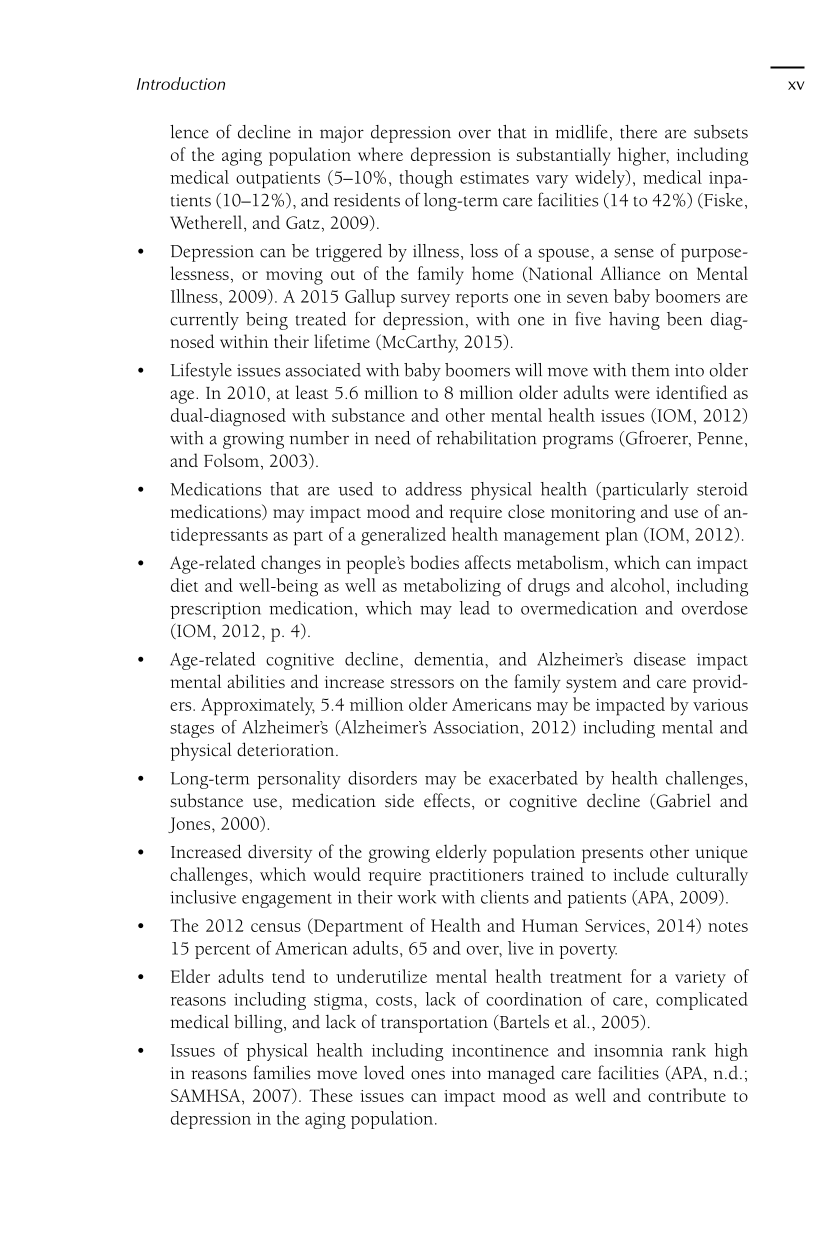Introduction xv
lence of decline in major depression over that in midlife, there are subsets
of the aging population where depression is substantially higher, including
medical outpatients (5–10%, though estimates vary widely), medical inpa-
tients (10–12%), and residents of long-term care facilities (14 to 42%) (Fiske,
Wetherell, and Gatz, 2009).
• Depression can be triggered by illness, loss of a spouse, a sense of purpose-
lessness, or moving out of the family home (National Alliance on Mental
Illness, 2009). A 2015 Gallup survey reports one in seven baby boomers are
currently being treated for depression, with one in five having been diag-
nosed within their lifetime (McCarthy, 2015).
• Lifestyle issues associated with baby boomers will move with them into older
age. In 2010, at least 5.6 million to 8 million older adults were identified as
dual-diagnosed with substance and other mental health issues (IOM, 2012)
with a growing number in need of rehabilitation programs (Gfroerer, Penne,
and Folsom, 2003).
• Medications that are used to address physical health (particularly steroid
medications) may impact mood and require close monitoring and use of an-
tidepressants as part of a generalized health management plan (IOM, 2012).
• Age-related changes in people’s bodies affects metabolism, which can impact
diet and well-being as well as metabolizing of drugs and alcohol, including
prescription medication, which may lead to overmedication and overdose
(IOM, 2012, p. 4).
• Age-related cognitive decline, dementia, and Alzheimer’s disease impact
mental abilities and increase stressors on the family system and care provid-
ers. Approximately, 5.4 million older Americans may be impacted by various
stages of Alzheimer’s (Alzheimer’s Association, 2012) including mental and
physical deterioration.
• Long-term personality disorders may be exacerbated by health challenges,
substance use, medication side effects, or cognitive decline (Gabriel and
Jones, 2000).
• Increased diversity of the growing elderly population presents other unique
challenges, which would require practitioners trained to include culturally
inclusive engagement in their work with clients and patients (APA, 2009).
• The 2012 census (Department of Health and Human Services, 2014) notes
15 percent of American adults, 65 and over, live in poverty.
• Elder adults tend to underutilize mental health treatment for a variety of
reasons including stigma, costs, lack of coordination of care, complicated
medical billing, and lack of transportation (Bartels et al., 2005).
• Issues of physical health including incontinence and insomnia rank high
in reasons families move loved ones into managed care facilities (APA, n.d.;
SAMHSA, 2007). These issues can impact mood as well and contribute to
depression in the aging population.









































































































































































































































































































